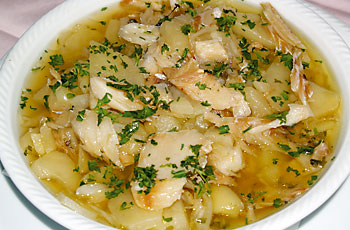Informant AB is a 23-year-old male who is from the East Bay in Northern California. He is a student at the University of Southern California in his third year as a civil engineer major. AB and his family have made a special Italian dish called Bagna Càuda for Easter for many generations. Bagna Càuda is a traditional Italian dish originated in Piedmont, Italy, which is typically made during the winter months of December and January:
AB: “Ever since I could remember, my Noni would make Bagna Càuda for Easter every year. It’s always been something she has enjoyed making.”
Where did your Noni learn this particular traditional meal?
AB: “She actually learned it from her parents who also learned it form their parents. Once my Noni’s parents immigrated to the United States from Italy, they brought the recipe with them and continued to pass it down throughout the years.”
Can you please explain what kind of Italian dish Bagna Càuda is for those who are not familiar?
AB: “Yes it’s kind of like a fondue, but it’s not like a cheese. It’s more of an oil, garlic, anchovy mixture that is really thin. It’s not a thick mixture. You take whatever it is whether it’s cabbage, mushrooms, red peppers, meat, or chicken and you put it in the garlic, the oil, and the anchovies and mix it all around and let it sit for a while. Once it is ready, it taste delicious.”
As a fellow Italian, I am familiar with this dish being made on Christmas and New Years in particular. Why did your family choose to carry on this dish only on Easter?
AB: “Well my Noni told me once that her parents often would make too much food on Christmas and New Years and there wasn’t enough time to get everything ready so they decided that they would only make this dish on Easter.”
Who do you invite over for Easter dinner?
AB: “Well since it’s Easter, we try to get all of our family members together to celebrate. We also invite a few friends to join in on the celebration. My Noni always ends up making too much food, especially the Bagna Càuda, but it’s a lot of fun.”
Will you continue to pass this traditional meal on as you get older?
AB: “I definitely do plan on carrying on this dish as I get older. Luckily I paid enough attention when my Noni made it over the years so now I can make it myself.”
What does this traditional meal mean to you?
AB: “Bagna Càuda is a dish that will forever remind me of the times as a young boy and the times that my Noni shared with her parents and the times that are spent over this meal.”
Analysis:
AB has fond memories of celebrating Easter with his grandmother and his family. AB’s example of the Italian dish, “Bagna Càuda,” is a representation of a family tradition that has been kept alive over many generations in an effort to preserve his family’s Italian nationality. As a fellow Italian, I am familiar with Bagna Càuda, as my family has made it before during the winter holidays, however, I found it very interesting how AB’s family only makes the dish on Easter. The ritual of making Bagna Càuda every Easter is a way that AB’s family connects to their Italian heritage and it keeps the memory of his grandmother’s parents alive. His desire to uphold his Italian roots is evident and he will continue to carry his family’s ritual along with him.

